I've long admired much of the older architecture at Washington University, which generally includes the Academic Gothic styles of medieval Cambridge and Oxford Universities in England.
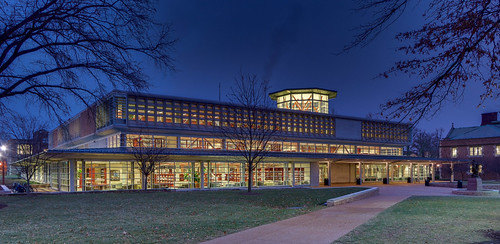
This is the John M. Olin Library, which opened in 1962, and is named after an ammunition manufacturer. I've spent many hours in this fine library, which has recently been redecorated.
I have a certain respect for the architecture of High Modernism, whose practitioners were classically trained and who saw art as a virtue that needed to be cultivated. This library was designed by Eugene Mackey and Joseph Murphy, who also designed the High Modern Saint Ann's Church in Normandy and Saint Peter's in Kirkwood. However, this well-designed but cold style died out in the 1960s; by that time, classical architectural curricula were gone and schools taught theories of art that derived from Marx rather than Aristotle.
The buildings constructed at Washington University from the late 1960s through the 1970s were sometimes inhumane — like Mudd Hall, an ugly concrete structure that lasted only a couple decades before its unlamented destruction. Holy Mother Church has long taught that beauty itself is a school that conforms the soul to goodness and truth — and that ugliness does the opposite. The campus in recent years has gone back towards the Academic Gothic style, albeit in the more simplified and ‘modernized’ fashion that characterizes the postmodern school of architecture.
The Gothic — or Catholic — style is perhaps the pinnacle of all architectural styles. Modernism is known for technological prowess, but largely lacks beauty; and the Romanesque and Byzantine styles were beautiful but clunky in construction: the Gothic style is both beautiful and technologically advanced. Perhaps a new school of architecture which incorporates an integral beauty married to contemporary technology can be developed.
This photo was taken about 20 minute before sunrise. Many architectural photographers like dusk and dawn for their subjects, especially at the moment when interior lighting balances the light from the sky. This time of year, dawn happens so quickly that finding the right balance is difficult.
Note: most of these photos were processed at full camera resolution. Click on any photo to get to a much larger version.
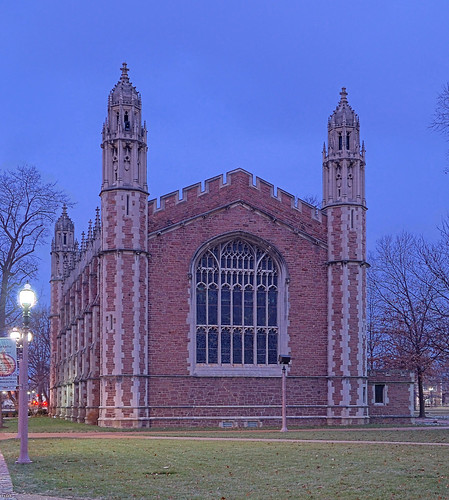
Graham Chapel was dedicated in 1909 and is named after industrialist Benjamin Brown Graham. This and most of the following buildings were designed by the firm of Cope and Stewardson. James P. Jamieson was the on-site supervisor for Cope during the initial construction of the university; later he formed his own firm, Jamieson and Spearl, which designed many more buildings on the campus between 1902 and 1950.
The stained glass window depicts the dedication of King Solomon's Temple, and was made by the firm of Clayton and Bell, of London, England. Although this is called a chapel, this building is not set apart for sacred worship, rather it is used as a concert and lecture hall.
Washington University was chartered by the Missouri State congress in 1853 as Eliot Seminary, named in honor of the Unitarian minister and co-founder William Greenleaf Eliot, but its name was quickly changed in honor of Founding Father George Washington. Eliot was also instrumental in creating the Saint Louis Art Museum, the Saint Louis public schools, and Mary Institute — which was named after his late daughter and not the Blessed Virgin. He was also the grandfather of the famed poet and Anglo-Catholic T.S. Eliot.
The Catholic Saint Louis University existed for decades before Washington University, so this school from its beginning was non-sectarian, with much of its historical leadership taken from liberal Protestant clergy and wealthy businessmen.
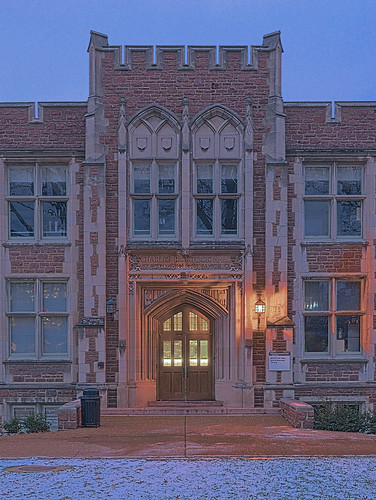
Charles Rebstock Hall was paid for and named after a liquor wholesaler. It dates from 1927 and houses the Biology department.
It was almost total darkness when I parked my car near here; 15 minutes later the sky was quickly lightening.
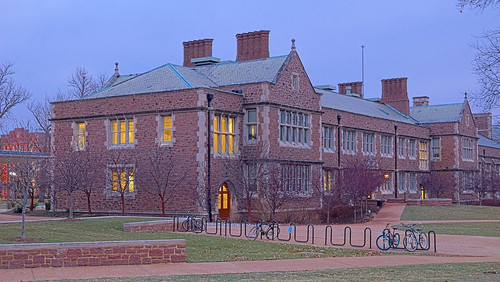
The James B. Eads Hall was completed in 1903; this and following buildings were the original structures on the campus. This is named after James Buchanan Eads, a self-taught engineer who made his fortune with the design of diving bells and salvage ships which retrieved the remains of shipwrecks; he built ironclad gunboats for the Union navy, and designed Eads Bridge, the first span over the lower Mississippi River.
Judging from the greenish color of the interior lights on this campus, evidently nearly all inside lights are fluorescent bulbs.
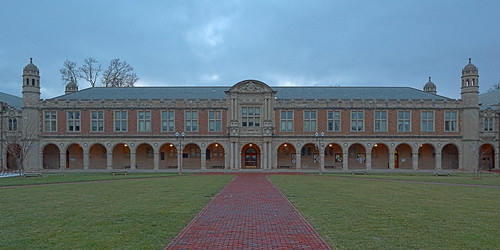
Construction of Stephen Ridgley Hall started in 1900, and is named after an industrialist and State Senator. During the 1904 World's Fair, this building was used for balls and meetings, and the second floor was occupied by the British Government, which displayed a collection of gifts to Queen Victoria from the occasion of her Diamond Jubilee. This building now houses the departments of Romance and Germanic languages.
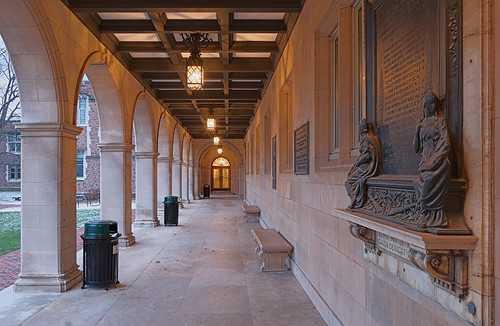
Covered walkways are very useful in Saint Louis, which suffers from brutal heat in the summertime and frequent thunderstorms, however this architectural element is not duplicated on the campus.
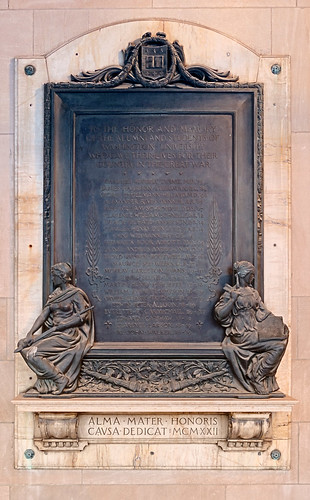
IN HONOR AND MEMORY
OF THE ALUMNI AND STUDENTS OF
WASHINGTON UNIVERSITY
WHO GAVE THEIR LIVES FOR THEIR
COUNTRY IN THE GREAT WAR
ALMA · MATER · HONORIS
CAVSA · DEDICAT · MCMXXII
A loving mother mourns for the loss of all her children, even if they were killed in an unjust war.
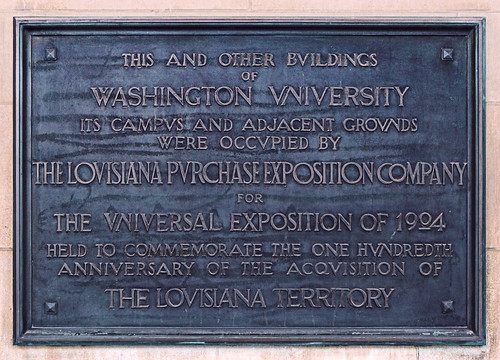
Washington University was located in downtown Saint Louis from 1853 to 1905. Plans to move the university out to the county started in the mid-1890s, and construction commenced here in 1900. Four of the nine original buildings were financed by a lease agreement with the Louisiana Purchase Exposition Company which operated the World's Fair of 1904, using these buildings for administrative offices and exhibition space. The 1904 Olympic Games were also held on these grounds.
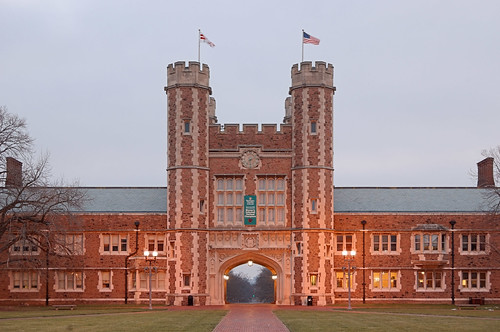
Brookings Hall serves as the administration building. It was completed in 1902 and is named after Robert S. Brookings, a wholesaler. My other photos of this building are here and here.
Inscriptions on the facade read:
Discere Si Cupias Intra: Salvere IubemusThe lights illumining the building turned off right after this photo, taken about six minutes before sunrise.
Cedunt Horae, Opera Manent
If you wish to learn, enter: we welcome you
The hours go by, the works remain
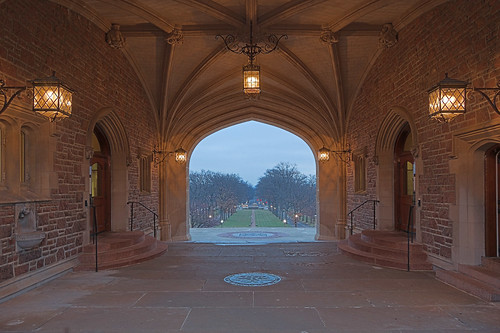
Archway under Brookings Hall looking to the east along Lindell Boulevard; the campus is adjacent to Forest Park.
Here we see a view downward; this was formerly called the Hilltop Campus (to distinguished this from the University's other sites) and was selected because of a resemblance to the Acropolis in Athens, Greece. The landscape architectural firm of Frederick Law Olmsted assisted in the original site planning.
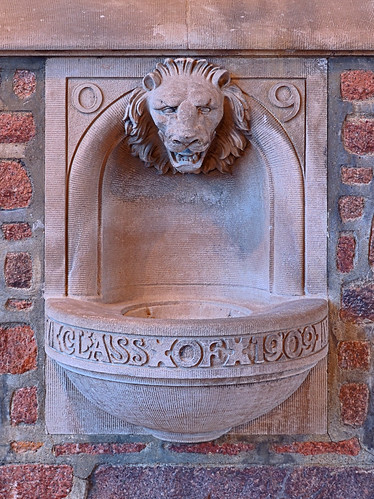
Lion gargoyle fountain.
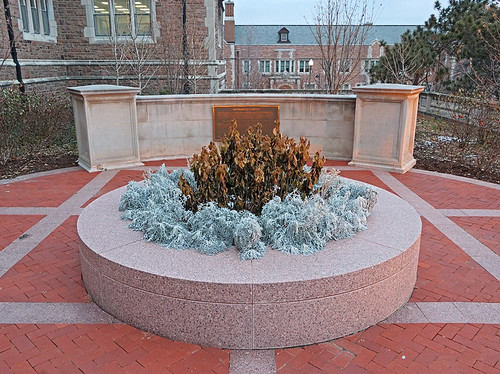
In front of Brookings Hall is Danforth Plaza, named after prominent patrons of the University. Here we see frost-covered vegetation in a planter.
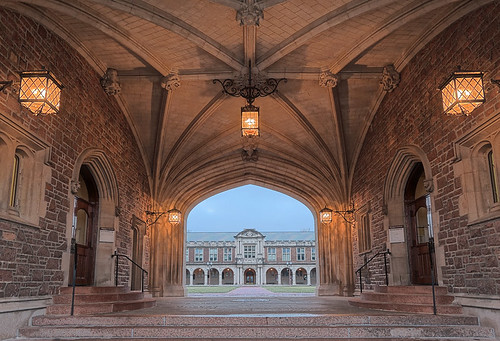
Another view under the archway of Brookings.
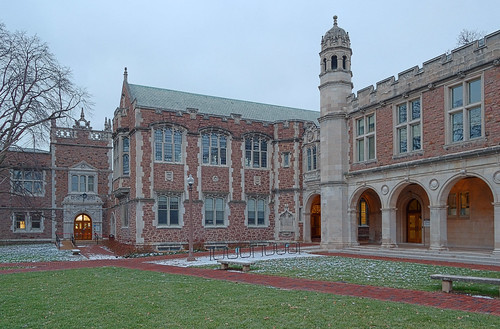
Grace Vallé January Hall, the former law school building, was completed in 1923 and was named after Brookings' mother-in-law. It now houses the Classics department and East Asian library.

Dedication plaque on January Hall.
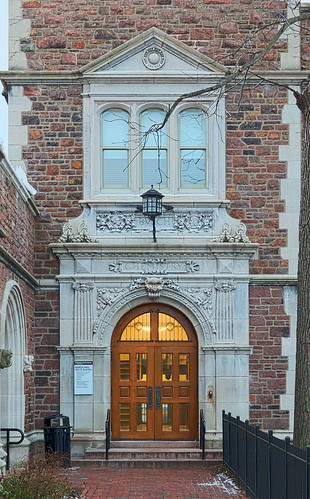
Doorway to Adolphus Busch Hall; the building is named after a brewer, and construction commenced in 1900. Originally the chemistry building, this and the other original science buildings on campus are in a Jacobean style, with neoclassical elements that more expresses the tastes of the Enlightenment. It now houses various humanities departments.
Most of the buildings on campus are faced with Missouri Red Granite and Bedford Limestone.
Click here for a map to the campus.

My alma mater...great shots. Olin Library was designed by Mackey and Murphy, but was renovated a few years ago in a way that many local Modernist fans dislike (at minimum).
ReplyDeleteNice pics. I took a few classes on campus a few years ago. The architecture is some of the finest I've seen on a university campus.
ReplyDeleteI don't think Eliot was a Catholic convert. Anglo-Catholic, maybe.
J.,
ReplyDeleteThanks for your compliment.
You are right about Eliot, and I changed it.